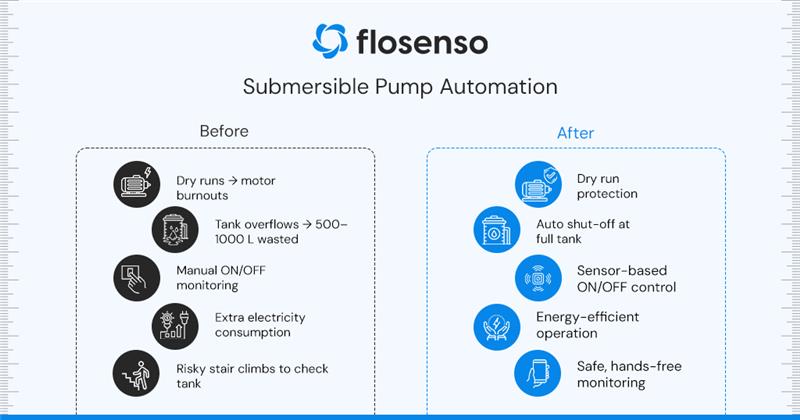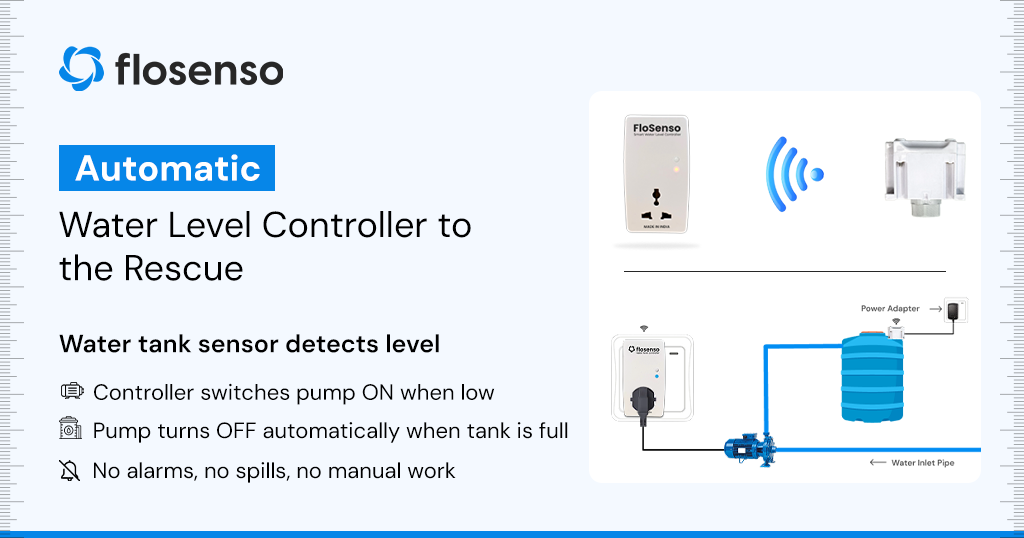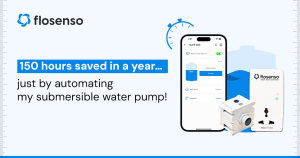Time is money, they say. But in my case, time was literally water. Every day, I was losing precious minutes (sometimes hours) babysitting my submersible water pump.
Sounds familiar? If you live in an Indian household with an overhead tank, you already know the struggle. You keep one ear open for the “gurgle” of the tank overflowing, the other on the “whirr” of the submersible motor pump, and your mind constantly running calculations, “Did I switch it off? Is the tank already full? Did the water supply even come today?”
Well, let me tell you my story of how I finally broke free from this daily drama and saved over 150 hours in a single year, just by automating my pump.
Story of my tryst with the water tank
My mornings used to start not with yoga or coffee, but with the “tank chase.”
- If the water supply came at 5 am, I was up at 4.30 am.
- If it came at 6:30 pm, I couldn’t step out because I had to “guard” the motor.
- If I forgot, the tank overflowed and turned my terrace into a mini waterfall.
And if you’ve ever had a submersible motor pump run dry because the supply stopped midway, you know the pain. Motors burn, electricity bills soar, and plumbers quote charges that make you wish you had a technical bent of mind.
Add to this the bonus round of water fights at home
- Mom shouting because the water overflowed onto the neighbour’s balcony.
- Dad fuming over the electricity bill.
- Me, running up and down the stairs like a part-time security guard for the tank.
By the end of the year, I realised I had spent an insane amount of time just waiting for tanks to fill. That’s when it hit me. This is madness!

Automation - The hero that rescued me
The solution came in the form of an automatic water level controller for submersible pump. A friend recommended it when I was ranting about my endless water woes.
To be honest, I wasn’t convinced at first. To be honest, I wasn’t convinced at first. I thought, ‘Come on, it’s such a simple thing, just switching the motor on and off. Do we really need automation for that too?”
But curiosity won. I ordered a smart water tank sensor and controller system, installed it, and within a week I knew this was making my life easy.
How does water pump automation work?
Don’t worry, I won’t complicate things with engineering diagrams. Here’s how this magic works:
- The water tank sensor is installed in your tank.
- It continuously checks how much water is inside.
- When the level drops below a certain point, the sensor tells the automatic water level controller to switch on the pump.
- As soon as the tank is full, it signals the controller to turn it off.
That’s it. No overflow, no dry run, no guesswork. Basically, your submersible water pump now runs smarter than your Wi-Fi router.
The 150 Hours Math
Let’s do the math. On average, I was spending at least 25–30 minutes daily:
- Switching on the submersible motor pump.
- Waiting for the tank to fill.
- Switching it off.
- Checking if it was really off.
That’s about 3.5 hours a week. Multiply that by 52 weeks = nearly 182 hours a year wasted.
With automation? That number dropped to less than 30 hours (only occasional checks and maintenance).
Net saving = 150+ hours every year.
150 hours! That amounts to –
- 75 full movies I could watch uninterrupted.
- A short vacation I never had time for.
- Or simply 150 hours of not climbing stairs like a madman.
Why every home needs an automatic water level controller
After automating my submersible pump, I realized that it isn’t luxury, but common sense that each household must make an effort to save the overflowing water and their energies.
Saves water, saves guilt
Every drop counts. Did you know an overflowing tank can waste up to 500–1000 litres of water in a single go? That’s like throwing away 10–15 buckets daily. Automation ensures not a single drop spills unnecessarily.
Protects your submersible motor pump
Dry run = motor damage = costly repairs. With automation, the controller ensures the pump never runs without supply. That’s extra years added to your motor’s life.
Cuts down your electricity bill
Running motors longer than needed eats electricity. Automation stops the wastage right when the tank is full.
Peace of mind
No more alarms. No more checking the terrace at midnight. No more missing family dinners because “Pump has to be switched off.”
Perfect for Indian households
Whether you live in a flat or an independent house, water pump automation is designed to fit in. And yes, it works perfectly with submersible motor pumps, overhead tanks, and even multiple tank setups.
How does a submersible pump work automatically?
Before I trusted my automatic water level controller to handle my submersible motor pump, I wanted to know exactly how this magic works. Turns out, it’s not rocket science, it’s just smart science.
Here’s the simple step-by-step guide to pump automation:

Installation
First, the pump is placed inside your water source, be it a borewell, sump, or underground tank. It needs to stay fully submerged so there’s no air bubble drama that interrupts the flow.
Sensor setup
A water tank sensor is installed to keep a constant eye on the water levels. Think of it as the “watchman” of your tank, starting the pump when water is low and stopping it when it’s full.
Controller – The brain
The controller reads signals from the sensor and tells the pump what to do. Add an automatic starter for submersible pump, and you don’t even need to press a single switch.
App setup
Want the pump to run every morning for 30 minutes? Or only when water levels dip to a certain point? The system can be programmed to follow your routine like the most disciplined family member you’ve ever had. The app associated with the system is programmed to take your commands for the pump and tank.
Monitoring in real time
The latest systems even alert you if something unusual happens—like abnormal water levels or a pump malfunction. So yes, to answer the classic question: “Do submersible pumps turn off automatically?” The answer is a big, confident yes—when paired with the right controller and sensors.
Understanding this helped me trust my water pump automation setup even more. It is not just about switching ON and OFF; but ensuring efficiency, saving water, and protecting your motor from damage. Whether you’re running a pump at home, on a farm, or even in an industrial setup, automation makes your submersible water pump work, with zero manual stress.
The water tank alarm vs the new automation
I used to rely on a water tank alarm earlier. Sure, it screamed when the tank was full, but guess what? I still had to run and switch off the motor. The alarm was more like a noisy boss pointing out mistakes without fixing them.
With an automatic water level controller, I don’t just get told, the job gets done. That’s the difference between old-school water tank alarms and smart automation.
Freedom in every drop
Honestly, automating my pump felt like moving from a basic Nokia phone to a smartphone. The difference is that dramatic.
If you’re tired of alarms, overflow dramas, and constant tank-checking, get yourself a smart automatic water level controller. Pair it with a reliable water tank sensor, and you’ll never look back.
For me, it wasn’t just about convenience, it was about reclaiming my time. 150 hours a year may not sound much on paper, but trust me, it feels relieved and relaxed.
So, if you’re still living in the “manual motor age,” take this as your sign. Automate your submersible motor pump today. Save time, save water, save your sanity.

Flosenso – For stress free water pumping
Flosenso is India’s very own automatic water level controller built with smart technology that talks directly to your pump and tank. Unlike the old-school water tank alarm that only screams when the tank is full, Flosenso does the heavy lifting, switching your motor ON when the water is low and OFF the moment the tank is full.
What I love most is how Flosenso made water management feel modern, like upgrading from a flip phone to a smartphone. Flosenso is not just about automation, but also about bringing convenience, sustainability, and safety into daily life.









